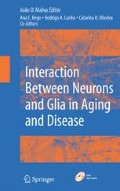All the major neurodegenerative diseases are characterised by the accumulation of proteinaceous aggregates within neurons. The commonest of such conditions, Alzheimer’s disease, also features extracellular proteinaceous aggregates (amyloid). The role of these aggregates in the aetiology and progression of cognitive impairment is still unclear, but their absence in young adults suggests that their removal would at any rate not be harmful.
Access this chapter
Tax calculation will be finalised at checkout
Purchases are for personal use only
Preview
Unable to display preview. Download preview PDF.
10. REFERENCES
Brooks, D.A., Kakavanos, R. and Hopwood, J.J., 2003, Significance of immune response to enzyme-replacement therapy for patients with a lysosomal storage disorder. Trends Mol. Med. 9: 450.
Cuervo, A.M., 2004, Autophagy: in sickness and in health. Trends Cell Biol. 14: 70.
de Grey, A.D.N.J., 2002, Bioremediation meets biomedicine: therapeutic translation of microbial catabolism to the lysosome. Trends Biotechnol. 20: 452.
de Grey, A.D.N.J., Alvarez, P.J.J., Brady, R.O., Cuervo, A.M., Jerome, W.G., McCarty, P.L., Nixon, R.A., Rittmann, B.E. and Sparrow, J.R., 2005, Medical bioremediation: prospects for the application of microbial catabolic diversity to aging and several major age-related diseases. Ageing Res. Rev. 4: 315.
De Rosa, R., Garcia, A.A., Braschi, C., Capsoni, S., Maffei, L., Berardi, N. and Cattaneo, A., 2005, Intranasal administration of nerve growth factor (NGF) rescues recognition memory deficits in AD11 anti-NGF transgenic mice. Proc. Natl Acad. Sci. USA 102: 3811.
Francis, J.C. and Hansche, P.E., 1972, Directed evolution of metabolic pathways in microbial populations. I. Modification of the acid phosphatase pH optimum in S. cerevisiae. Genetics 70: 59.
Gayle, E.F., 1952, The Chemical Activities of Bacteria. Academic Press, London.
Ghosh, P., Dahms, N.M. and Kornfeld, S., 2003, Mannose 6-phosphate receptors: new twists in the tale. Nat. Rev. Mol. Cell Biol. 4: 202.
Hoffner, G., Kahlem, P. and Djian, P., 2002, Perinuclear localization of Huntington as a consequence of its binding to microtubules through an interaction with beta-tubulin: relevance to Huntington’s disease. J. Cell Sci. 115: 941.
Lewis, T.A., Newcombe, D.A. and Crawford, R.L., 2004, Bioremediation of soils contaminated with explosives. J. Environ. Manage 70: 291.
Ma, Q.L., Lim, G.P., Harris-White, M.E., Yang, F., Ambegaokar, S.S., Ubeda, O.J., Glabe, C.G., Teter, B., Frautschy, S.A. and Cole, G.M., 2006, Antibodies against beta-amyloid reduce abeta oligomers, glycogen synthase kinase-3-beta activation and tau phosphorylation in vivo and in vitro. J. Neurosci. Res. 83: 374.
Pardridge, W.M., 2002, Drug and gene delivery to the brain: the vascular route. Neuron 36: 555.
Paresce, D.M., Chung, H. and Maxfield, F.R., 1997, Slow degradation of aggregates of the Alzheimer’s disease amyloid beta-protein by microglial cells. J. Biol. Chem. 272: 29390.
Rose, K. and Steinbuchel, A., 2005, Biodegradation of natural rubber and related compounds: recent insights into a hardly understood catabolic capability of microorganisms. Appl. Environ. Microbiol. 71: 2803.
Roses, A.D., 1994, Apolipoprotein E affects the rate of Alzheimer’s disease expression: beta-amyloid burden is a secondary consequence dependent on APOE genotype and duration of disease. J. Neuropathol. Exp. Neurol. 53: 429.
Ross, C.A., Wood, J.D., Schilling, G., Peters, M.F., Nucifora, F.C., Cooper, J.K., Sharp, A.H., Margolis, R.L. and Borchelt, D.R., 1999, Polyglutamine pathogenesis. Philos. Trans. R. Soc. Lond. B Biol. Sci. 354: 1005.
Schenk, D., 2002, Amyloid-β immunotherapy for Alzheimer’s disease: the end of the beginning. Nat. Rev. Neurosci. 3: 824.
Schenk, D., 2004, Hopes remain for an Alzheimer’s vaccine. Nature 431: 398.
Schenk, D., Barbour, R., Dunn, W., Gordon, G., Grajeda, H., Guido, T., Hu, K., Huang, J., Johnson-Wood, K., Khan, K., Kholodenko, D., Lee, M., Liao, Z., Lieberburg, I., Motter, R., Mutter, L., Soriano, F., Shopp, G., Vasquez, N., Vandevert, C., Walker, S., Wogulis, M., Yednock, T., Games, D. and Seubert, P., 1999, Immunization with amyloid-β attenuates Alzheimer-disease-like pathology in the PDAPP mouse. Nature 400: 173.
Schiffmann, R. and Brady, R.O., 2002, New prospects for the treatment of lysosomal storage diseases. Drugs 62: 733.
Tuszynski, M.H., Thal, L., Pay, M., Salmon, D.P., Sang, H., Bakay, R., Patel, P., Blesch, A., Vahlsing, H.L., Ho, G., Tong, G., Potkin, S.G., Fallon, J., Hansen, L., Mufson, E.J., Kordower, J.H., Gall, C. and Conner, J., 2005, A phase 1 clinical trial of nerve growth factor gene therapy for Alzheimer’s disease. Nat. Med. 11: 551.
Warhurst, A.M. and Fewson, C.A., 1994, Biotransformations catalyzed by the genus Rhodococcus. Crit. Rev. Biotechnol. 14: 29.
Wittich, R.M., 1998, Degradation of dioxin-like compounds by microorganisms. Appl. Microbiol. Biotechnol. 49: 489.
Wittlin, S., Rosel, J., Hofmann, F. and Stover, D.R., 1999, Mechanisms and kinetics of procathepsin D activation, Eur. J. Biochem. 265: 384.
Author information
Authors and Affiliations
Editor information
Editors and Affiliations
Rights and permissions
Copyright information
© 2007 Springer Science+Business Media, LLC
About this chapter
Cite this chapter
Grey, A.D.N.J.d. (2007). Rejuvenating Neurons and Glia with Microbial Enzymes. In: Malva, J.O., Rego, A.C., Cunha, R.A., Oliveira, C.R. (eds) Interaction Between Neurons and Glia in Aging and Disease. Springer, Boston, MA. https://doi.org/10.1007/978-0-387-70830-0_23
Download citation
DOI: https://doi.org/10.1007/978-0-387-70830-0_23
Publisher Name: Springer, Boston, MA
Print ISBN: 978-0-387-70829-4
Online ISBN: 978-0-387-70830-0
eBook Packages: Biomedical and Life SciencesBiomedical and Life Sciences (R0)

